Whether you are renting a car, a campervan, or an RV in Ireland, there are some things you should know about driving in Ireland. We thought long and hard about all the things we wished we would have known before we got behind the wheel, and put them together in one convenient place for you.
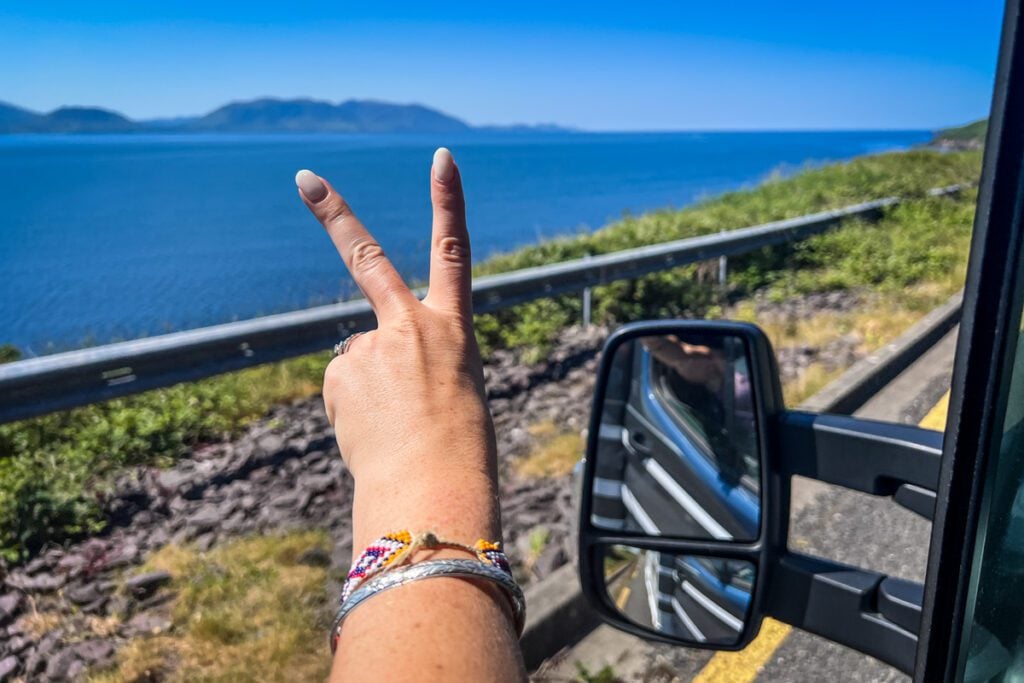
Hopefully, our advice will help ease your nerves about driving in Ireland and you can learn from our mistakes and avoid getting (expensive!) tickets while on your road trip!
1. In Ireland they drive on the left side of the road
You’re researching renting a car in Ireland, so hopefully you are already well aware of this! The driver seat and the steering wheel will be on the right side of the car and you will drive on the left side of the road.
If you’re used to driving on the right-hand side of the road, we have a few pieces of advice:
- If this will be your first time driving on the left-hand side, we’d recommend specifically choosing an automatic vehicle, so you don’t have to think about stick shift and driving on the opposite side of the road.
- You may also want to choose a vehicle that is roughly the size of your own car (if possible) so that you’re only throwing one new thing into the mix.
- The first day will be a little tricky, so don’t plan on driving too long of a distance. Give yourself some time to get used to it, and it will get easier! Pretty soon, it’ll feel totally normal, and when you get home you’ll have to remind yourself how to drive on the right-hand side!
- You got this!
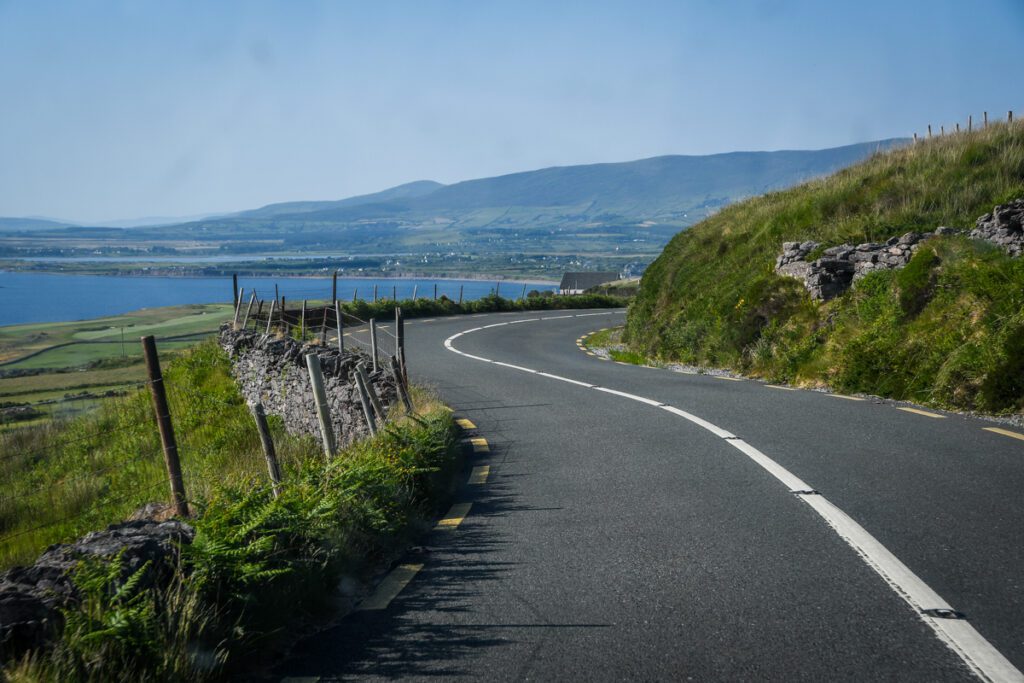
When I first started driving on the opposite side of the road, I found myself reverting back to the basics. Taking things slowly, looking at all the signs, and following the car ahead of me at a reasonable distance.
But when I started to get the hang of it, I realized that most of driving is just safely following the person ahead of you. There is a lot to think about when driving in another country, but this simple fact helped me get more comfortable when renting a car in Ireland.
Read more: We put together a guide with everything you need to know about renting a car in Ireland.
2. There are roundabouts everywhere
They are all over the country – from tiny villages to the big cities – so be prepared. Some of them are very small while others have several lanes.
Be sure to yield to the traffic to the right of you.
And if you end up taking the wrong exit, just roll with it and hopefully you have a GPS (check our tips in the coming sections) that can quickly reroute you.
3. The roads can get very narrow
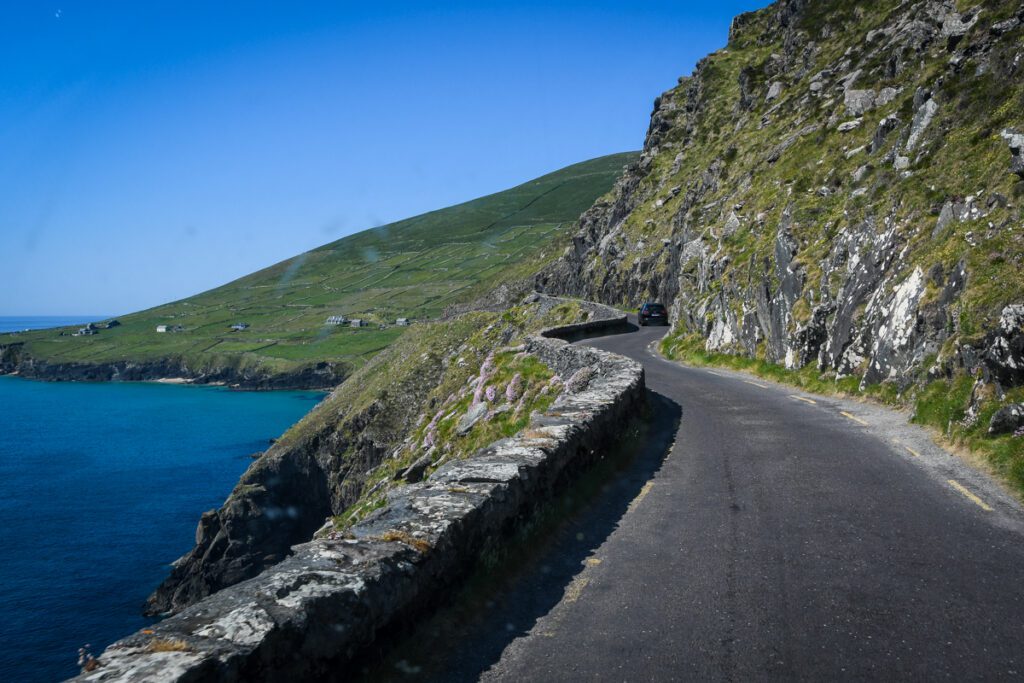
Like very narrow.
Many of the roads were constructed long ago when people used horses to get around. Yes, really! So it makes sense that they’re not very roomy.
Keep this in mind, especially if you’re driving a campervan or larger vehicle. We had a few close encounters when we were driving through small villages that had old stone walls lining the street.
There are a lot of 2-way roads that really are only big enough for one vehicle at a time.
When you encounter this, be patient.
You might need to pull over and wait for oncoming traffic to stop. There are often small pull-outs (called “passing places”) for this purpose, so keep a lookout for them.
4. Get an eSIM to help with navigation
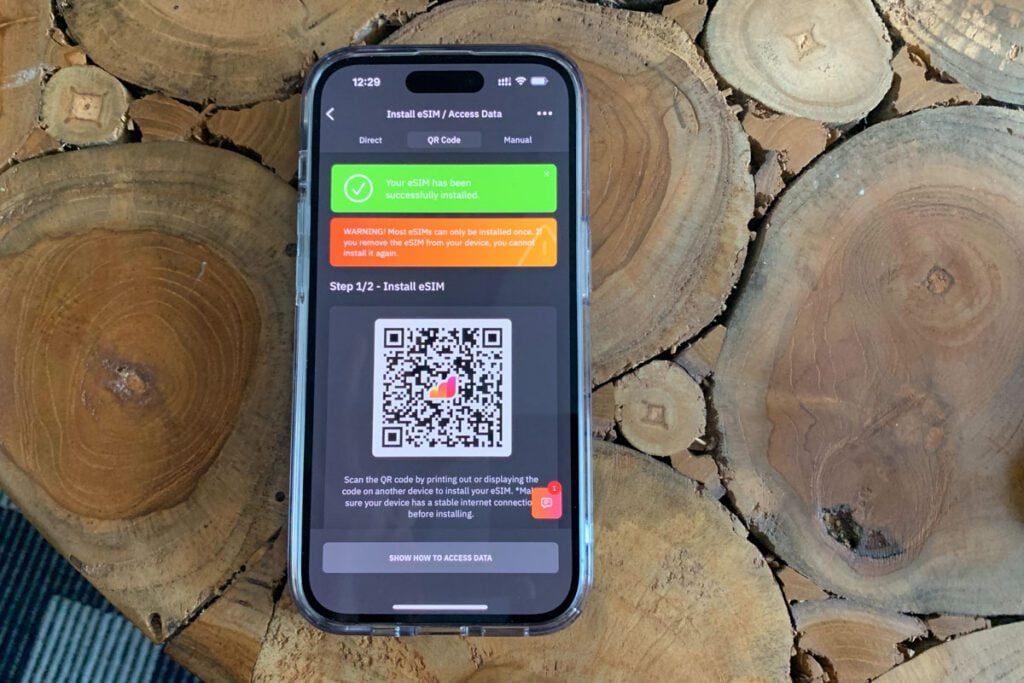
We used Airalo to get data during our trip and it was seamless!
Plus, our 10G of data was super affordable, at just $22 USD.
Note: If you do plan to go into the North of Ireland, that technically is the United Kingdom and an Ireland cell plan will not work. If you plan to travel between the Republic of Ireland and Northern Ireland, you may want to purchase an entire European Airalo plan. It is only a few dollars more and you’ll be covered wherever you go.
It was really nice knowing that we were using local cell towers so we had the best coverage possible. That said, there are some places in the Irish countryside where cell service is weak or non-existent.
For that reason, it’s important to follow the next tip…
Psst! Will you be traveling in more than one country? Use our ultimate guide to getting an international SIM card, including helpful tips for using your phone abroad.
5. Download offline Google Maps just in case
We always recommend downloading the offline version of Google Maps when renting a car in Ireland (or any other country) so that you can still have access to your GPS location and the map when you go out of cell range.
This will also help you plan your route to be the most efficient because petrol in Ireland is not cheap (2023 prices were floating around $7 USD/gallon).
Psst! This article explains how to download offline Google Maps if you’re not familiar with the process.
6. Pack a phone mount
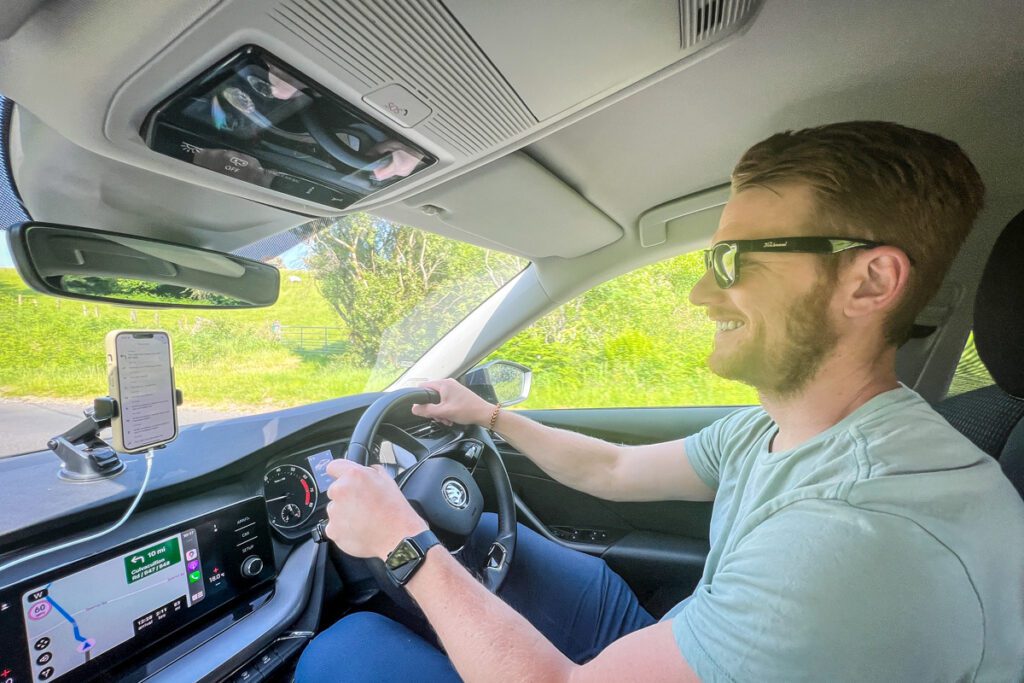
One thing that is often overlooked when renting a car in Ireland is having a place to keep your phone while driving.
I don’t know about you, but I love being able to see Google Maps without craning my neck or looking down in my lap. Been there, done that, and it’s not fun (or safe!).
Pack your phone mount from home (or get a new portable one specifically for travel) so that you can have your navigation conveniently displayed. It’ll make getting around so much easier, I promise!
And don’t forget to bring a spare phone cord so that you can just leave one in the rental car. Packing a 12 Volt USB port car plug is also handy since most cars have these ports and you can keep your phone’s battery full.
7. Know the speed limits
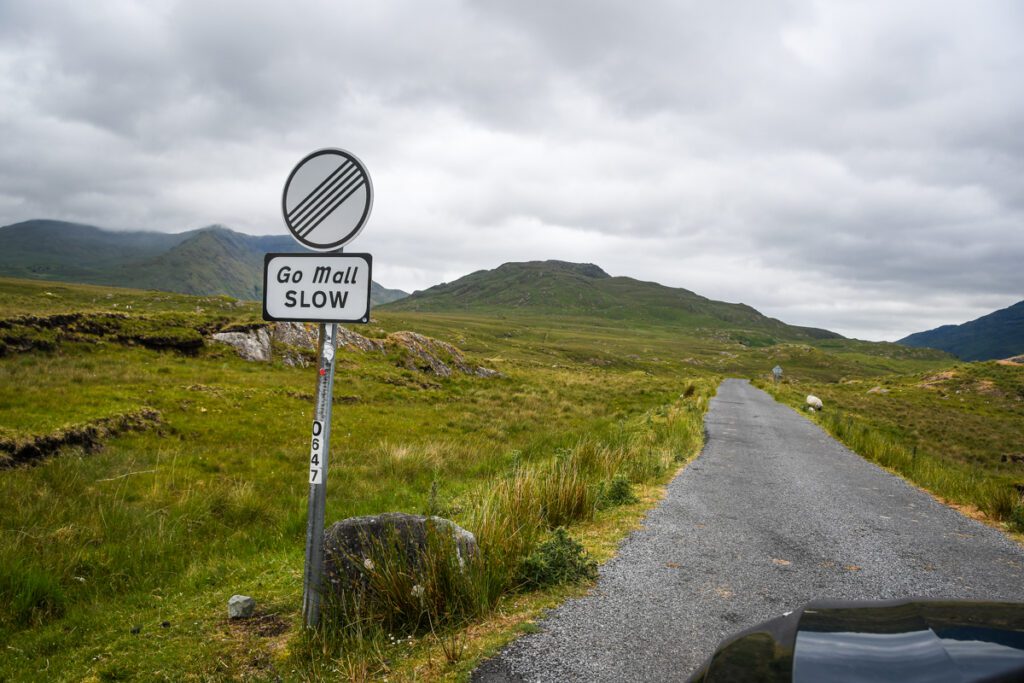
Speed limit signs are circular and outlined in red. The number on them will be in kilometers per hour, while in the Republic of Ireland. In Northern Ireland, the speed limit signs will be in miles per hour.
Most roads in Ireland are labeled with a combination of a letter and a number. Here are the most common:
- M is for Motorway: these are most like interstate highways in the US with large, multi-lane, wide highways. If you look at a map of Ireland, you can see all the M motorways spreading out of Dublin. Typically the speed limit is 120 km/h (roughly 70 mph) but they do tend to vary. One motorway you will most likely encounter is M50 which circles Dublin and has a toll (more on this later) you’ll have to pay online.
- N is for National: there are highways that connect major cities. The general speed limit is 100 km/h (roughly 60 mph), but don’t feel like you have to go that fast. These roads can be pretty curvy in certain sections.
- R is for Regional: these are the smaller roads between towns and villages or around major cities. Typically the speed limit is 80 km/h (about 50 mph) but this speed tends to be way too fast for these winding narrow roads.
- L is for Local: even smaller than regional roads. Some are dirt roads. Some have tall hedges on both sides of the road making it hard to see far.
If you don’t see a speed limit sign, Google Maps should tell you what it is. However, drive at the speed you’re comfortable with, and allow others to pass you when there are opportunities.
8. You will most likely pass a toll (and not know it)
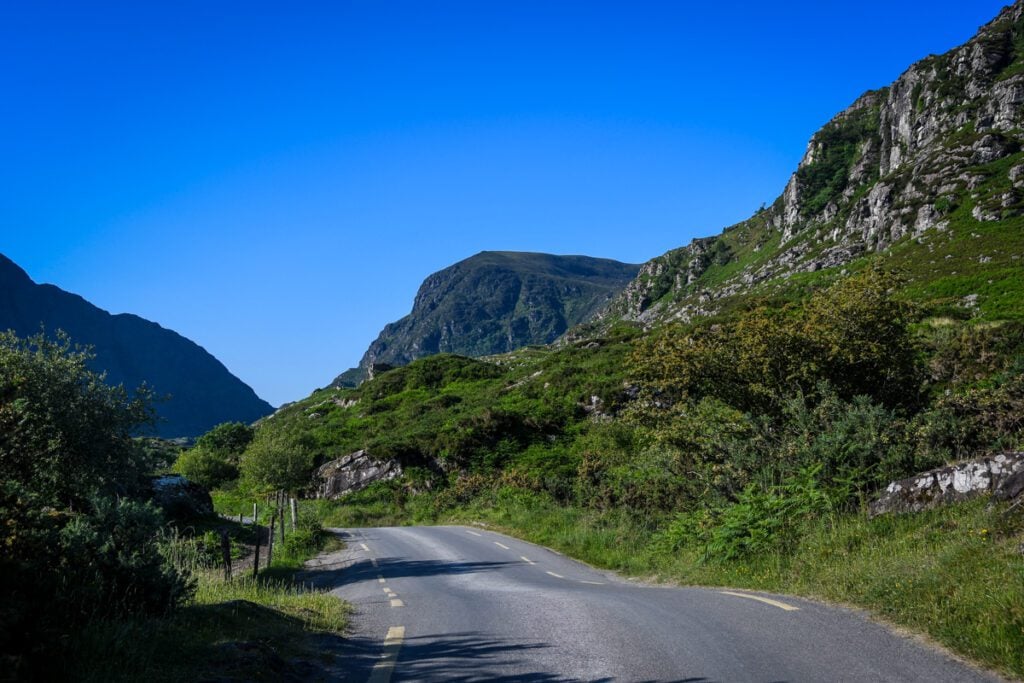
As of 2023, there are 11 toll roads in Ireland. 10 of the tolls are drive-up barriers and you pay at a machine or booth operator. You can pay with a card or cash at all except the East-Link bridge in Dublin, which only takes exact change or a pre-paid pass.
There is one toll road that you’ll probably pass under while driving in Ireland and if you’re not paying attention you could easily miss it.
The M50 motorway that circles Dublin has a barrier-free toll that uses videos and sensors to record your car’s license plate while driving. Even though you are renting the car, you are still required to pay the toll online.
For a regular car traveling on the M50, the cost of the toll will be about €2.90 (2023 prices), and you can pay your toll online at eflow.ie. Just enter your license plate registration number and it will show the dates your vehicle was on the motorway.
You can pay your M50 toll before your journey or before 8 p.m. the following day after you have used the toll. If you don’t pay your toll before 8 p.m. the following day, you will have to pay a penalty.
9. There are speed cameras on all types of roads
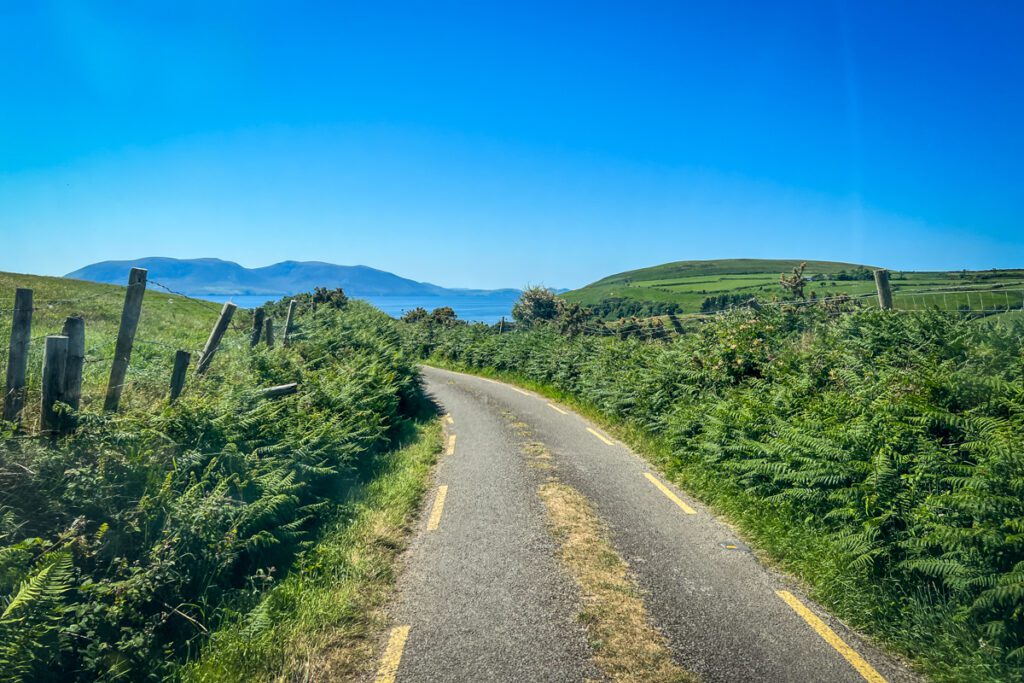
There are typically signs letting you know your speed is being monitored by CCTV.
Don’t be a dummy, follow the speed limit and you won’t be stuck with tons of outlying speeding ticket fees.
10. Fill up on fuel often
When renting a car in Ireland, it’s smart to fill your tank often, especially when traveling on countryside roads.
We typically seek out a petrol station (you read that correctly, it is not a gas station in Ireland) once our tank hits half full.
Be sure to know which type of fuel our car or van takes. Our camper required diesel, while our rental car took petrol.
11. Parking can be difficult in big cities
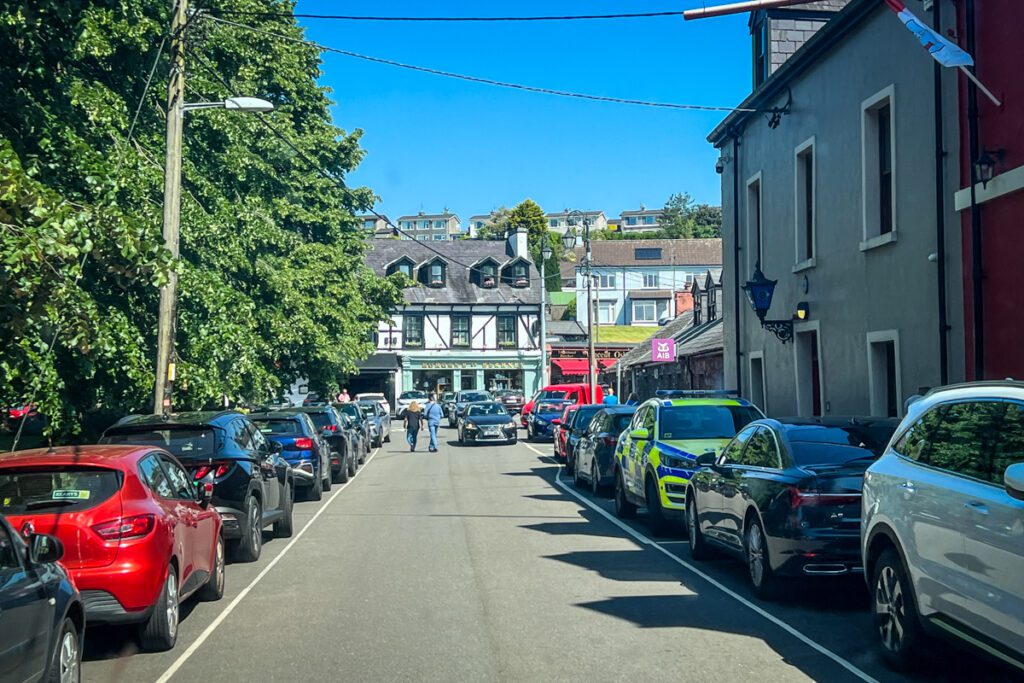
The most stressful thing about our road trip in Ireland was finding parking in big cities.
If possible, don’t rent a car until after your stay in Dublin or Galway.
It’s very easy to get around by walking and using public transport in both of these cities, so having a car is not necessary.
That said, maybe you’ll be staying in one of the big cities in the middle of your trip. If this is the case, we’d advise you to make sure your accommodation provides parking. If they don’t, ask them where they’d recommend parking.
If you’re just visiting for the day, search “public parking” in Google Maps to be led to the nearest lot.
We even used a Park and Ride free shuttle service when we were exploring the city of Cork. It was so nice not having to find and pay for parking in the big city.
Insider Tip: If you are driving a motorhome, it is also a good idea to view Google Maps in “satellite mode” so you can see if it is a lot or a parking garage. You can also see if it is spacious enough for your vehicle. Sometimes on satellite mode, we would see other large vehicles in the lot, which was a good sign for us.
I will say that our motorhome was a little tricky to maneuver in some public parking lots, as it was bigger than a typical parking space, leading to a few stressful situations. And of course, our rental car had no issues in parking lots.
12. Many paid parking lots monitor using CCTV
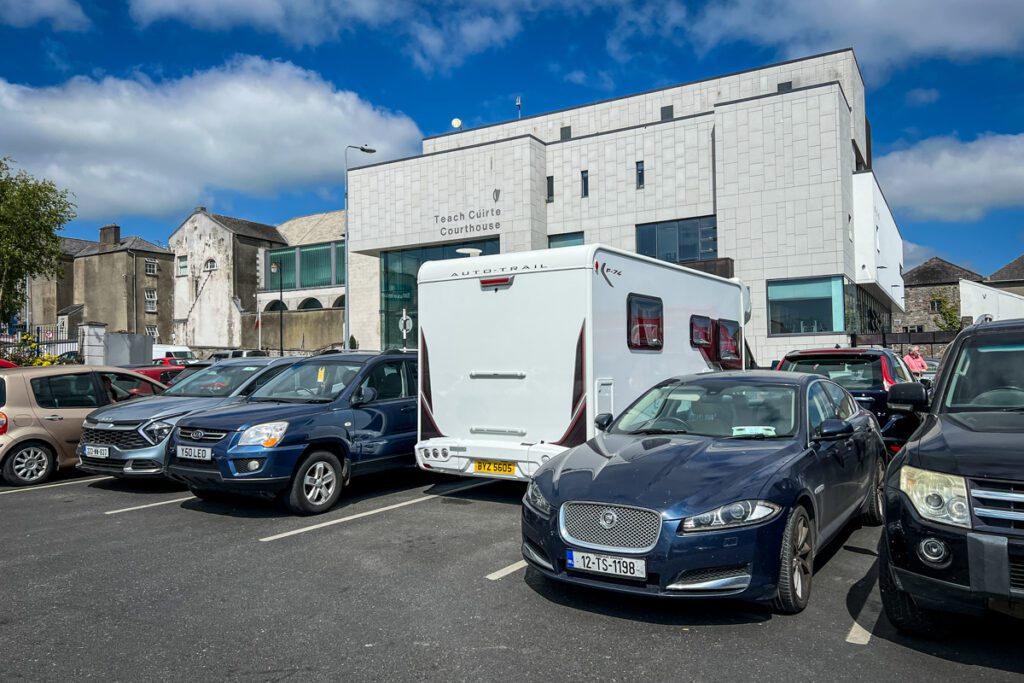
For some lots, this means your license plate is recorded the moment you enter.
When you want to leave the lot, the machine will tell you how much you owe based on their surveillance. It’s pretty nifty, actually because you only pay for the exact amount of time you’re parked.
However, sometimes, it’s not so obvious. The lesson here is if you need to pay for parking up front, choose an amount of time you know you won’t exceed, as the lot may be using CCTV to make sure you don’t overstay.
Always settle up at a Paid Parking Kiosk before returning to your car to leave. You’ll typically have 15 minutes to exit the parking area, so don’t dilly-dally.
13. Look out for sheep
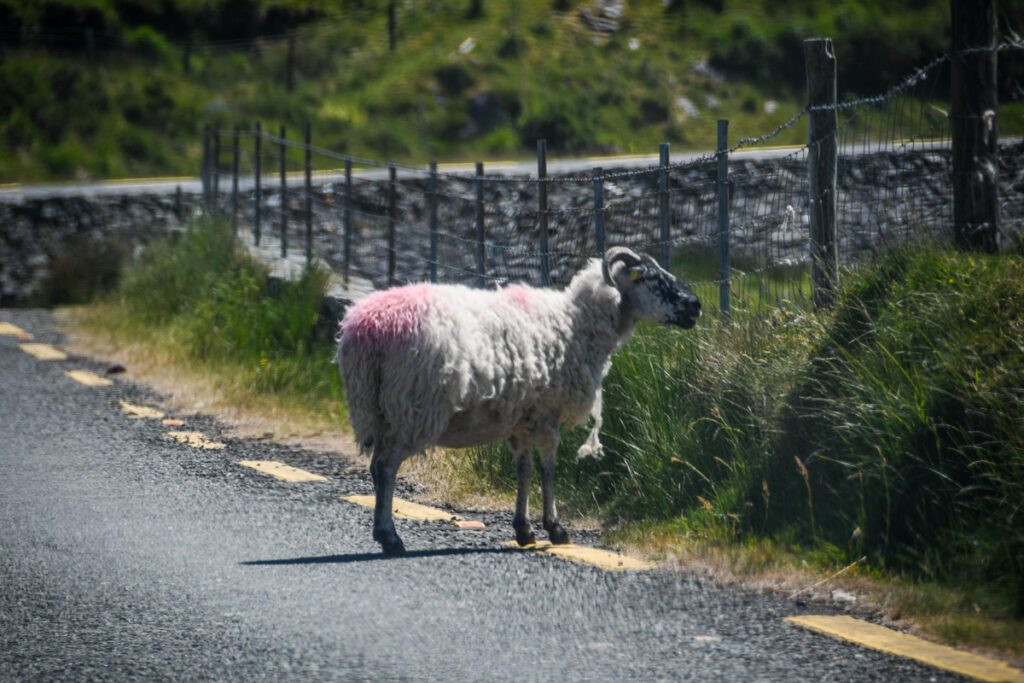
The Ring of Kerry was one place where we saw a lot of sheep.
When driving in rural areas be careful because livestock is likely nearby. There are often signs that warn you of these areas, but you should always be on the lookout.
And in forested areas, be on the lookout for deer and other wildlife.
14. Know what to do in case of an accident
Dial 112 or 999 emergency services if you get in an accident.
It’s good to know that 112 is the European standard emergency number, whereas 999 is the United Kindom emergency number. Both work in Ireland.
However, it’s also good to know if your rental car company has a number to call for towing or maintenance.
If you have a data-only phone package, emergency numbers should still work. But get the WhatsApp number of your rental car company in Ireland so you can contact them.
15. Pack this just in case…
Whenever we rent a car or campervan in another country, we travel with this portable jumpstart kit.
Here’s why…
While driving the Ring Road in Iceland, our campervan battery died in a parking lot. We had no cell service. And no other vehicles nearby had jumper cables (as it was a touristy area and most people were also travelers).
It started torrentially raining, and we had to hitchhike to a nearby farm (after knocking on at least 5 other doors!) in order to finally get jumper cables.
Immediately after returning home, we bought this super portable jumpstart kit that allows you to self-jump, meaning you don’t need to have another vehicle nearby.
This is especially a good idea if you’ll be traveling through the Irish countryside where you might be in some remote areas.
So learn from our travel horror story and pack your own portable jumpstart kit just in case! Hopefully you won’t have to use it, but it will give you peace of mind knowing you won’t be stranded.
And you won’t have to hitchhike in the pouring rain, like we did!
BTW: Yes, you can fly with it! Since the jumpstart kit has lithium batteries, you must pack it in your carryon bag.
16. Don’t drive after a pint
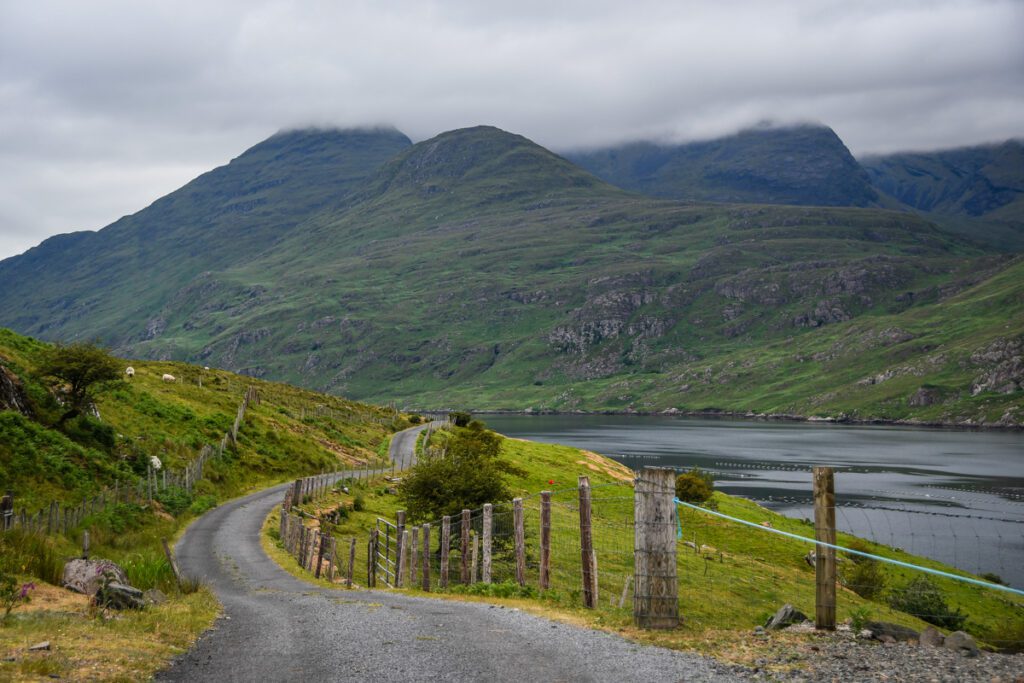
This one should be obvious. At this point, we should all be able to agree that drinking and driving is wildly dangerous.
However, this is on our list because Ireland and most of the rest of Europe have stricter laws on drinking and driving compared to the US and Canada.
The legal blood alcohol limit in Ireland is 0.05% (BAC of 50mg), whereas this limit is 0.08% in the USA.
This equates to less than one glass of wine or one pint of beer.
So if you plan to have a drink with a meal before hopping behind the wheel, make sure it’s a non-alcoholic one or that you give yourself enough time between the beverage and driving. Or have a designated driver, it’s as simple as that.
17. Don’t get distracted by the scenery
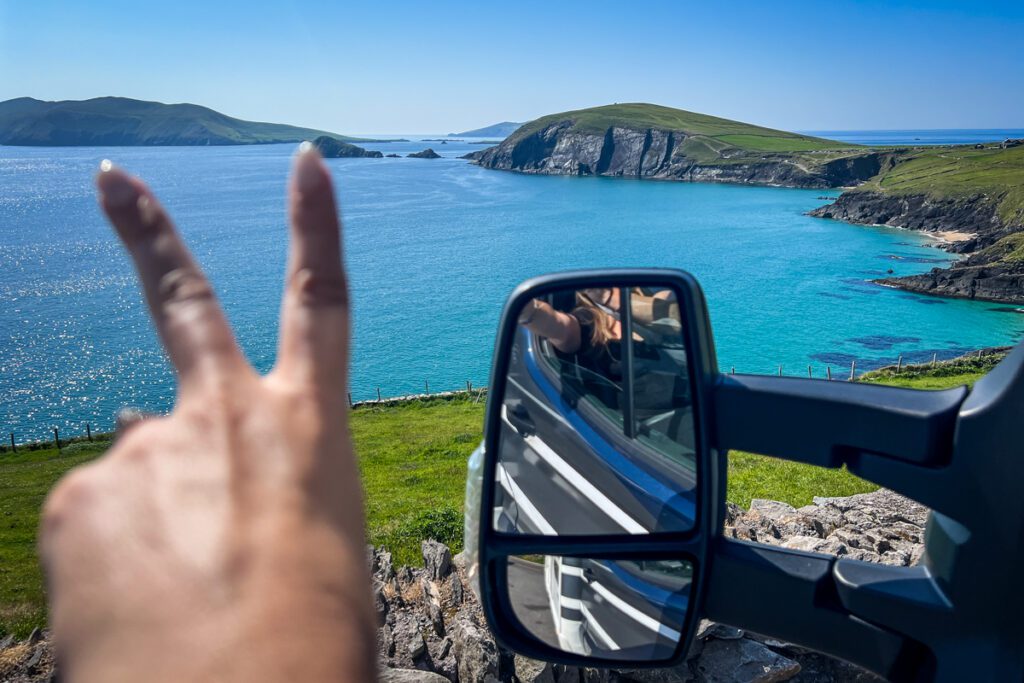
This is a tough one because Ireland is freaking beautiful, but, keep your eyes on the road!
It can be tempting to want to look at all the stunning scenery, so when the urge strikes, look for a pull-out (there are plenty!) where you can pause and enjoy the landscape.
Especially on the Ring of Kerry and the Dingle Peninsula, there are amazing viewpoints and loads of spots to pull over and take it all in!
18. Take a ferry and save time!
I’m all for taking the scenic route, and when you’re driving in Ireland, basically the whole country is the scenic route.
However, sometimes it just makes sense to take a shortcut and ride on a ferry with your vehicle.
There are a few vehicle ferries in Ireland, but the one that we recommend taking is on the Wild Atlantic Way crossing over the Shannon River, from Tarbert to Killimer.
On our trip, we traveled from the Dingle Peninsula to the Kilkee Cliffs. By taking the Shannon River Ferry, it saved us at least 100km and 30 minutes of driving around the city of Limerick. At $7 USD per gallon of petrol, fuel costs really add up in Ireland.
At the time, we were traveling in our rental camper so the ferry cost was €28.80 for the camper and all passengers inside. Regular cars cost €20.70.
It’s recommended that you book your tickets in advance so you get a discounted price and the ferry can fill up so make sure you grab a spot. Book your ferry tickets here.
19. Instead of Uber, use these apps
Okay so this tip is not exactly for when you are driving, but it’s about transportation so we thought to include it here.
One thing that surprised us in Ireland was that when we ordered an Uber, a taxi showed up. After this happened a few times, we realized that in Ireland, Ubers are not private drivers like we’re used to in the US.
It essentially just connects you to a taxi.
Turns out Ireland does not allow private drivers to operate using rideshare apps and only allows licensed taxi and limo drivers to do so.
However, here’s the issue…. We found ourselves waiting. And waiting. This happened a lot when we ordered Ubers. And we weren’t quite sure why…
Then we learned from a local that there are far fewer drivers on the Uber app than are on these other apps:
Both are only available in select cities in Ireland. So if you’re in a place where the apps don’t work, simply hail a taxi since it is the same price as the apps anyway.
What to pack for driving around Ireland
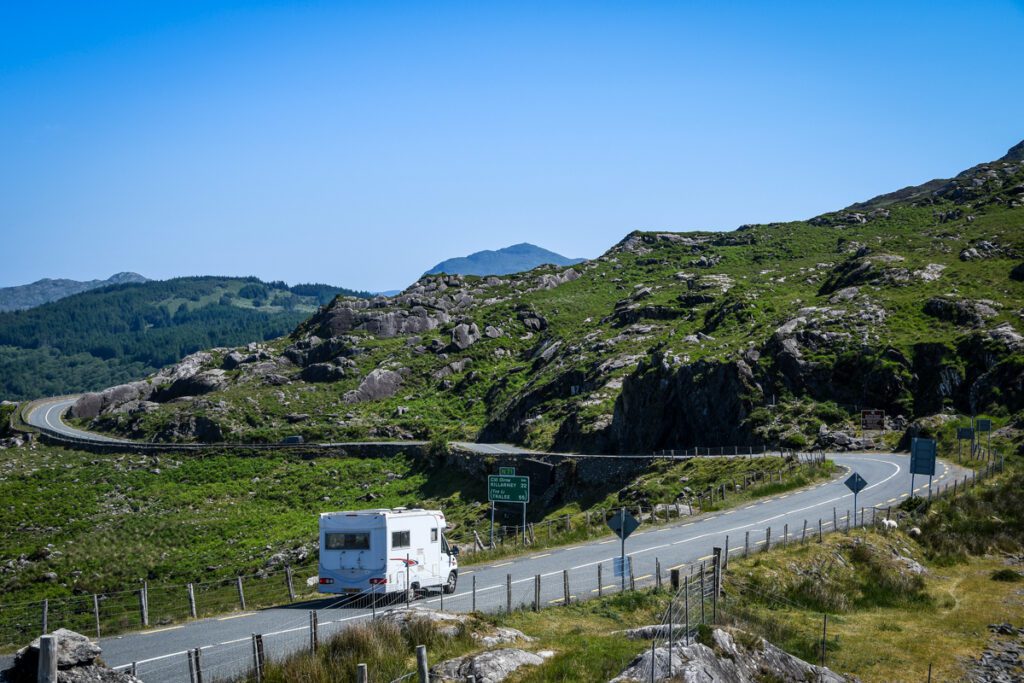
We have a whole checklist of things to pack for your trip to Ireland, but here are some general items you don’t want to forget on your road trip.
- Driver’s license
- Dashboard mount: Safety first! You’re not allowed to use your phone while driving in many places (plus, it’s just unsafe!), so attach your Google Maps to your dash.
- Sunglasses: Umm, yeah, this is a must. No explanation needed.
- Travel Lumbar Pillow: If you have a bad back (like Ben!), this would be clutch! He had some back issues during our trip, and was wishing we had packed his lumbar pillow. It’s way too bulky to fly with though, so I found this pillow for next time!
- Water bottle: Must have on a road trip. Our favorite is Hydro Flasks because they keep your water so cold!
- Aeropress: If you are a coffee drinker, definitely pack this!
- Travel Mug: Bring your own coffee cup into cafes and save on waste (and sometimes a few cents!)
- Universal Outlet Adaptor: A basic travel item that everyone should have so you can plug in your device anywhere.
- Car Outlet Inverter: While you’re driving, charge your larger devices like laptops and cameras with a portable inverter that plugs into your car.
- Portable jumper cables: This tiny little device has a power pack that effectively jumps your vehicle (without another car).
- Travel insurance: We NEVER travel without it, but especially for a road trip, it’s a good thing to plan for.
Be sure to download our complete packing list for Ireland! It’s packed with good suggestions and insider tips to help plan your Scotland trip. And it’s completely FREE, so why not!?
Plan your trip to Ireland
We absolutely fell in love with exploring Ireland by campervan, and we have tons of resources to help you plan an epic adventure of your own. Start with our Ireland Travel Guide and be sure to check out the articles below:
- First time planning? Start here with our ultimate Ireland trip planning guide — full of tips (and mistakes to avoid!).
- Check out the top places to visit in Ireland — you won’t want to miss these gems!
- Don’t miss these unforgettable things to do in Ireland — the ultimate bucket list!
- Wondering when’s the best time to visit Ireland? We’ve got the answers (plus when you might want to avoid).
- Renting a campervan? Here’s our guide to the best campervan rentals in Ireland (with expert tips!).
- Prefer cozy beds to campgrounds? Check out these dreamy Ireland glamping stays.
- If you’re renting a car instead, read this essential guide to renting a car in Ireland (plus key warnings!).
- If you’re renting a car instead, read this essential guide to renting a car in Ireland (plus key warnings!).
Save this article on Pinterest for later!
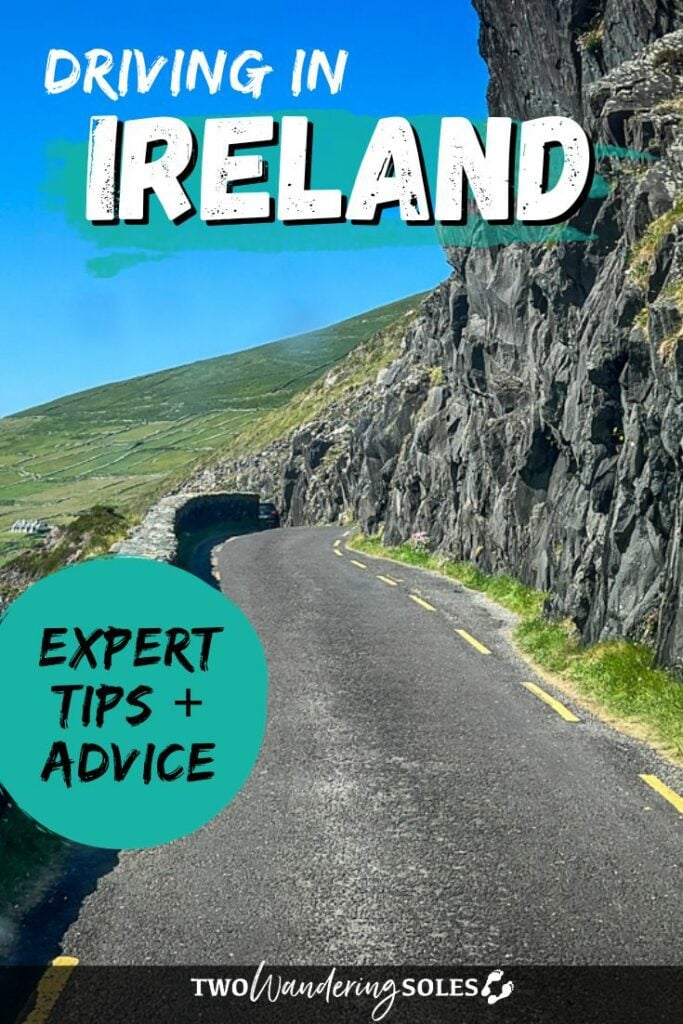
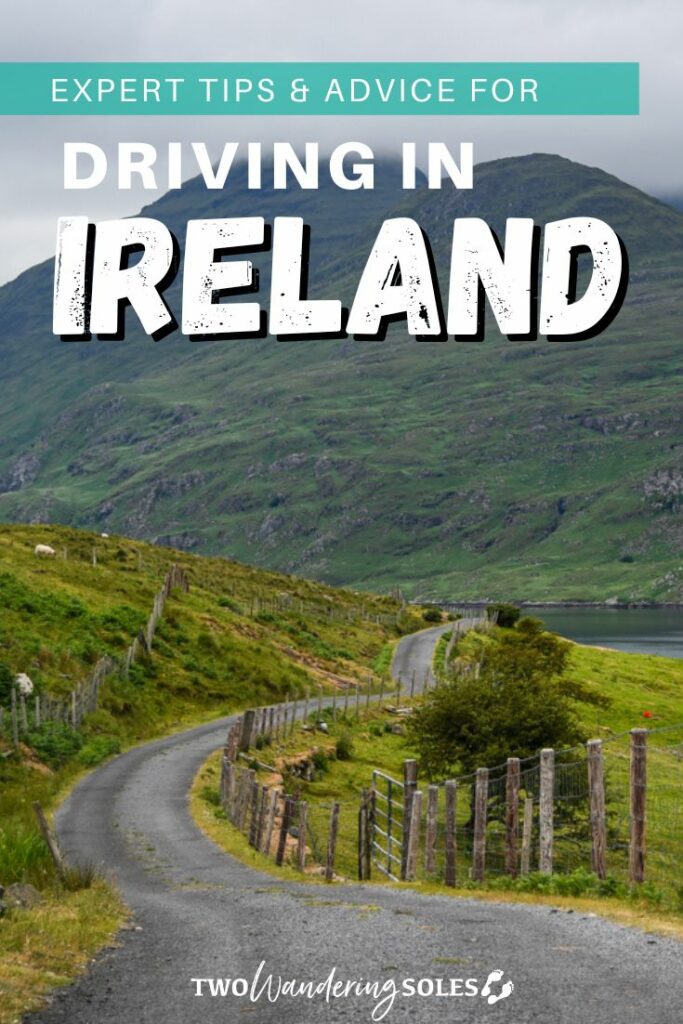
We want to hear from you!
Do you have more questions about driving in Ireland that we didn’t cover in this article? Are you planning a road trip and want more info? Leave us a comment below and we’ll do our best to get back to you!
Well, hello there!
I’m Ben. A recovering Type-A personality that quit a career in engineering to travel the world.
Crazy? Maybe. Regrets? None.
I am the sous chef to Katie’s head chef, and I am the navigator to her “let’s get lost” attitude. I love that we work as a team whether we’re traveling, cooking or working on this blog.
Wanna know more? You got it!

